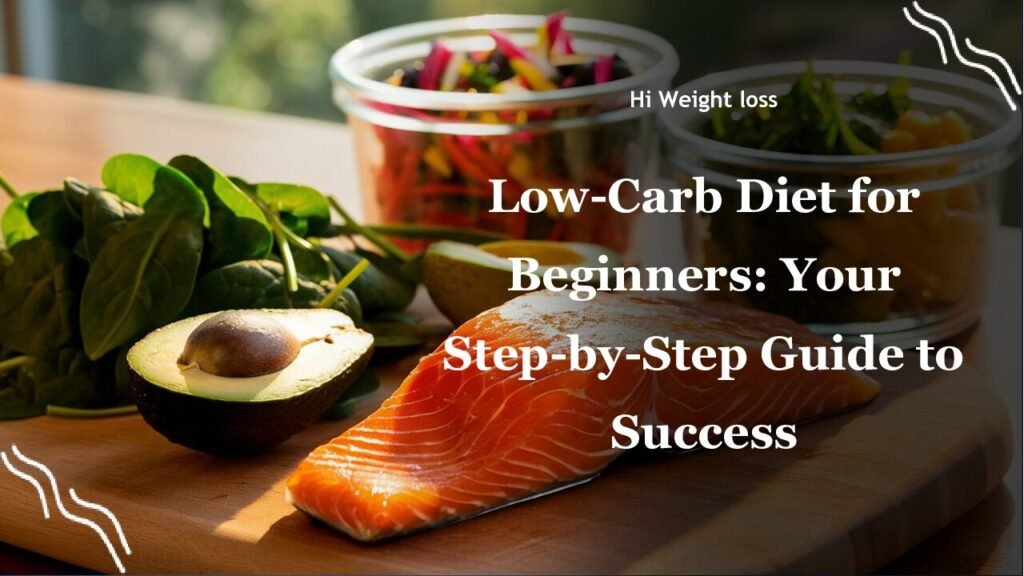“`
Feeling overwhelmed by the idea of starting a low-carb diet? It’s a common feeling, especially when you’re bombarded with conflicting information. Imagine a friend, Sarah, who always struggled with energy slumps in the afternoon, and after several weeks of research, she started a *low-carb diet* and within a couple of weeks started to notice that the afternoon slump was gone and she felt more energetic. This article will guide you step-by-step on how to start a low-carb diet effectively and sustainably, ensuring that you achieve the results you want without the stress, so that you can start a healthier life.
How to Start a Low Carb Diet for Beginners?
Assessing Your Current Eating Habits
Before jumping into a *low-carb diet*, it’s essential to take a moment to look at your current eating patterns. Understanding where you are starting from is key. Are you a big fan of pasta or do you always reach for the bread basket?
Knowing your current diet is like having a roadmap before you start a journey. This will help you understand which areas you can improve and tailor your diet plan. Begin by keeping a food journal for a few days, noting everything you eat and drink. This doesn’t have to be perfect, just a general overview.
Pay attention to when you tend to eat the most carbs, and if these carbs are providing you with a sustained release of energy, or causing you to crash afterwards, then you can start building a plan that will work best for you. In my own journey, I realized I relied heavily on sugary snacks to get through the workday, which was ultimately contributing to my energy crashes. Understanding this allowed me to make better choices.
Identifying the Right Low-Carb Foods
Now, let’s talk about what you *can* eat on a low-carb diet. The key is to focus on nutrient-dense, whole foods. We’re talking lean meats like chicken and turkey, fatty fish like salmon and mackerel, and eggs. Leafy green vegetables and non-starchy vegetables such as broccoli, cauliflower, and spinach are also excellent choices.
Don’t forget about healthy fats. Avocados, nuts, and seeds are your friends here. These are not only satisfying but also keep you feeling full longer. What’s great is that they are naturally low in carbs, and high in protein and healthy fats as mentioned in Healthline. It’s not just about restricting carbs; it’s about nourishing your body with the right stuff.
Think about it, swapping out a sugary cereal with some scrambled eggs and spinach in the morning already significantly reduces your carb intake and increases your protein intake. This simple change can make a big impact.

Creating a Weekly Eating Plan
Planning is essential for success with any diet, and it is no different with the *low-carb diet*. This approach helps ensure you have all the meals planned for the week, so you don’t have to wonder what to cook on the spot, which can lead to unhealthy options.
Plan your meals in advance, incorporating a good source of protein, healthy fats, and non-starchy vegetables. For instance, Monday could be grilled chicken with roasted broccoli, Tuesday could be salmon with a mixed green salad, and so on. This structure will help you stay consistent and minimize the temptation to veer off your dietary path. My friend, Tom, swears by this, he said it felt like he was planning to go on vacation. He planned his diet as if he was planning a trip.
Meal planning really helps you stay on track with your *low carb diet* and minimizes the chances of making unhealthy choices at the last minute. I find that spending an hour on Sunday planning my meals for the week has always been incredibly helpful and a game changer.
Batch Cooking for Convenience
Let’s be real – life gets busy. This is where batch cooking becomes a lifesaver. Preparing large portions of your meals ahead of time and storing them in individual containers can be a game-changer. This approach can greatly enhance consistency with your meals and also makes it easier to stick to a low-carb approach.
Consider cooking a big batch of chili (using low carb ingredients) or roasting a lot of vegetables at once, this way you can have a healthy meal readily available that is within your low-carb diet and will save you time and effort during the week. Not only does it reduce the temptation of going off course, but also ensures nutritional compliance, as shown by the Awesome Health Club.
Think about how much time you might spend during the week if you didn’t have this option; batch cooking is definitely a game changer!.
Using a Shopping List Effectively
Armed with your weekly meal plan, you will find going to the grocery store much easier. Creating a shopping list based on your planned meals is crucial to avoid buying high-carb items. This is your chance to set yourself up for success, make sure you stick to the perimeter of the store where you can find fresh produce and proteins.
You would find most of the processed, high-carb food options in the aisles. This simple act of sticking to the perimeters of the supermarket, and avoiding the aisles as much as possible, will significantly help you on your *low carb diet* journey. I have found it incredibly helpful to stick to my shopping list. It’s saved me from buying things that will take me off track, this also saves me money!.
I know for sure, shopping lists and meal planning are key for a *low carb diet* to work effectively!
Experimenting with Low-Carb Recipes
Eating the same things every day can get boring and make sticking to any diet a real struggle. The secret to long term adherence is variety. You can avoid the monotony by experimenting with new low-carb recipes, the internet has an abundance of resources that will spark creativity and make it easier for you to keep up with your diet.
Don’t be afraid to try new ingredients and cooking styles. There are so many different things that you can create by just following a recipe. The key is to find something that you will enjoy, and that you will want to eat consistently. For example, if you really love pizza, then search for some low carb alternatives, like a cauliflower crust. Or if you love rice, try some cauliflower rice. It doesn’t mean you have to give up everything you love!
Exploring new recipes can make your *low carb diet* feel less like a chore, and more like an adventure. It really does make things easier to adhere to.
Tracking Your Progress Effectively
To really keep track of your progress and stay accountable, you need to monitor your carb intake and your weight. It is also a good idea to regularly check and adjust your diet if needed. This means keeping a food diary to monitor your progress, this is a great way to keep track of what you are eating.
If you’re feeling like you are not getting the results you want, then consider adjusting what you are eating to make it work for you, this might take time, but being consistent with your tracking will be useful. It’s not just about weighing yourself; it’s about understanding how your body is responding to the changes. Tracking helps you to spot the patterns, and allows you to make the necessary changes.
In my experience, I found the food diary to be incredibly useful, it has allowed me to pinpoint exactly what I was doing right, and what I needed to change to make my *low carb diet* effective.
Gradual Reduction of Carbohydrates
If you are new to the low-carb approach, consider starting with a gradual reduction of carbs instead of jumping into a very restrictive diet. A rapid change can cause side effects, such as fatigue or headaches. The key is to make this a lifestyle, and not just a short term approach.
Think about easing into it, your body will thank you. By slowly removing certain high carb items from your diet and gradually replacing them with low carb alternatives will make the transition much easier. This is because your body will have time to adapt, and you would be avoiding some of the side effects associated with a rapid diet change. Research supports a gradual approach to minimize side effects.
A slow transition with a *low carb diet* is more sustainable and will make it much easier in the long run.
Low-Carb Foods to Include: A Simple Table
Here is a simple table summarizing some great low-carb options for your diet:
| Food Group | Examples |
|---|---|
| Lean Meats | Chicken, Turkey, Beef, Pork |
| Fatty Fish | Salmon, Mackerel, Tuna |
| Eggs | Whole eggs, egg whites |
| Leafy Greens | Spinach, Kale, Lettuce |
| Non-Starchy Vegetables | Broccoli, Cauliflower, Asparagus, Zucchini |
| Healthy Fats | Avocados, Nuts, Seeds, Olive Oil |
Conclusion
Starting a low-carb diet doesn’t have to be a daunting task. With a structured plan, you can make a smooth and sustainable transition to healthier eating habits. Just like my friend Sarah, who finally overcame her afternoon energy slumps, you too can find a sustainable way of eating by taking a structured approach and following a step by step guide. Remember to assess your current habits, focus on nutrient-dense foods, plan your meals in advance, and don’t be afraid to explore new recipes.
Track your progress, and make gradual adjustments as needed, and you will see changes. Batch cooking, shopping list and a gradual reduction of carbs can make the whole process much easier. By following these steps, you will not only be managing your weight more effectively, but you will also be improving your overall health. If you found this useful, do feel free to share this article with your friends.
FAQ
What are the main benefits of starting a low-carb diet?
A *low-carb diet* can lead to significant improvements in weight management, and also can help improve energy levels, and blood sugar control. These benefits come from reducing the amount of carbohydrates, which can stabilize blood sugar and reduce cravings.
Can I eat fruit on a low-carb diet?
Yes, but in moderation. Some fruits are lower in carbs than others, such as berries, which can be included in small amounts. Avoid those fruits that are high in sugar such as bananas and mangoes.
How long does it take to see results on a low-carb diet?
Results vary, some people might see changes in a few weeks, while for others it may take longer. Consistent adherence to the diet and regular exercise will help you see better results. Keep track of your progress in a journal and stay consistent.
“`



